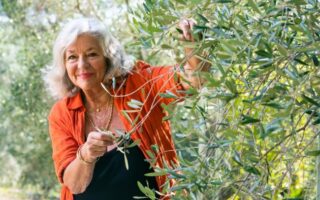Flâneries in Paris: Sunshine and Sculptures along the Seine
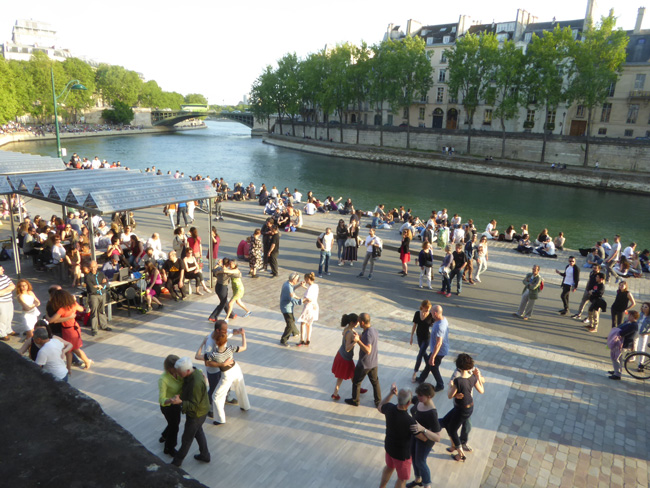
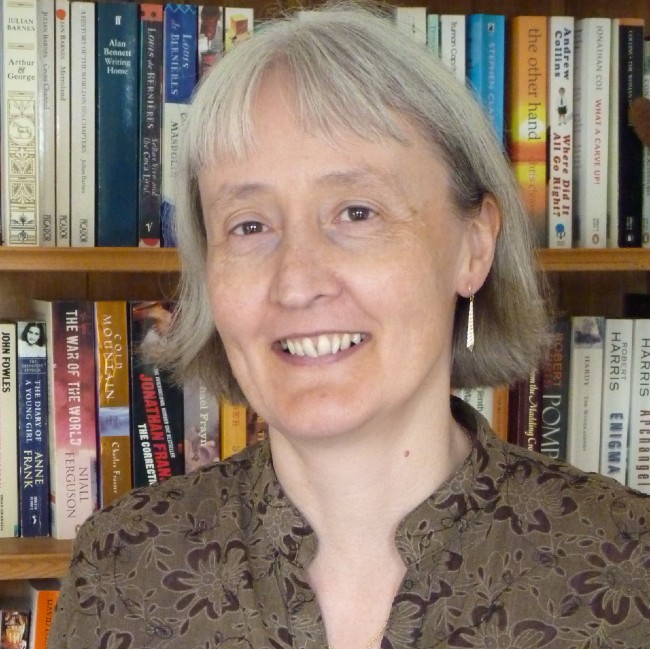
- SUBSCRIBE
- ALREADY SUBSCRIBED?
BECOME A BONJOUR PARIS MEMBER
Gain full access to our collection of over 5,000 articles and bring the City of Light into your life. Just 60 USD per year.
Find out why you should become a member here.
Sign in
Fill in your credentials below.
This is the 16th in a series of walking tours highlighting the sites and stories of diverse districts of Paris.
It was clear from the briefest of glances at a map of the 4th and 5th arrondissements that a stroll looping around the Pont du Sully and the Pont d’Austerlitz was an intriguing prospect. I could take in both banks of the river, passing over the tip of the Île Saint-Louis and through the Jardin Tino Rossi, the city’s outdoor sculpture museum. Perfect for a sunny afternoon.
The Sully-Morland metro station seemed the place to start. Within minutes, halfway across the Pont de Sully, arresting Paris views opened up on both sides. To my left, the Tours Duo, proving that Paris, shy of new skyscrapers lest they spoil the city’s beauty, is willing to take the odd risk. Being lopsided, one seemingly threatening to topple into the other, these towers catch the eye straight away. Their height is a factor too, the larger one being 180 meters. In all of the city, only Mesdames Eiffel and Montparnasse are taller. Quite jaunty, I thought, and if you’re going to build new towers, why settle for nondescript?
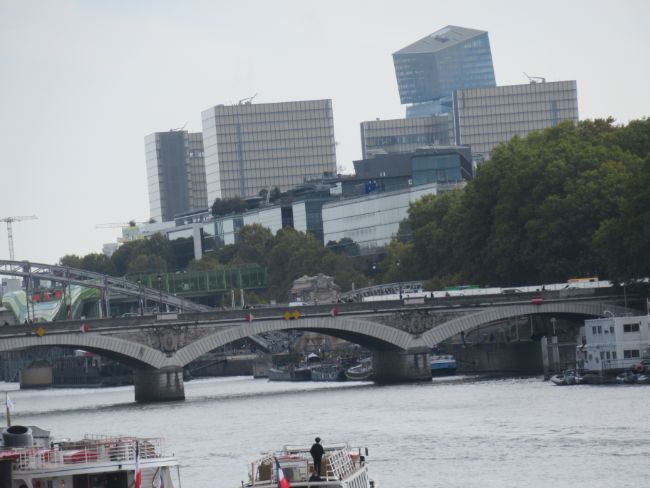
In the distance rises the Tours Duo, a new pair of skyscrapers designed by architect Jean Nouvel, situated in the 13th in eastern Paris. Photo credit: Marian Jones
And to my right, the back of Notre-Dame and an unfamiliar glimpse of another well-known sight. Just by the next bridge towered a statue of Geneviève, patron Saint of Paris. When glimpsed, as she usually is, from the other side, perhaps on a boat trip rounding Île de la Cité, she has her back to you. But from this side she is welcoming you in. Her sculptor, Paul Landowki, had wished it otherwise, remarking “How sorry I am, when I stroll around, to see that awful pillar of my poor Saint Geneviève.” But I like the way she stands protectively atop an enormous obelisk, greeting new arrivals. It’s 1500 years since she led a prayer marathon and encouraged Parisians to see off Attila the Hun. But she’s still there, keeping a watchful eye.

Statue of Saint Geneviève, the Patron Saint of Paris, created in 1928 by Paul Landowski, located on the bridge of the Tournelle, Paris. Photo credit: Yair Haklai/ Wikimedia Commons
The little park accessed from halfway over the bridge is fittingly named the Square Barye, after the 19th-century sculptor, Antoine-Louis Barye, best known for his bronze animal figures. And just around the left-hand corner at the end of the bridge I came to the entrance to the outdoor sculpture park, the Jardin Tino Rossi. The information board promised a place where “culture and nature are in dialogue,” and I was soon to discover that in this pretty riverside garden there is not just artwork, but also music and dance.
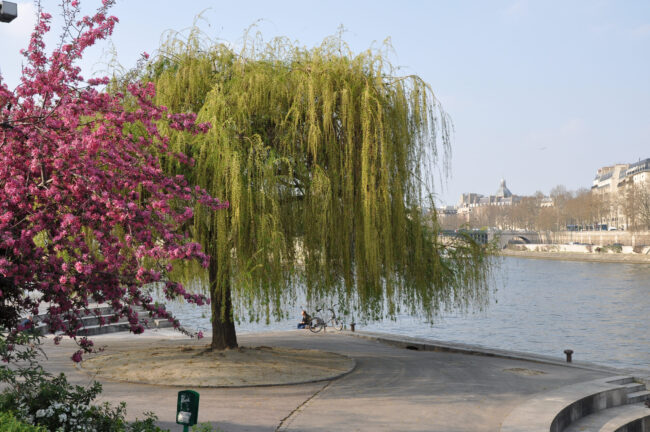
The quay of the Seine in the Jardin Tino-Rossi.. Photo credit: Moonik / Wikimedia commons
My first impressions were unsettling. Was that strange, waist-high edifice actually a sculpture? It looked like a giant mushroom in a state of decay. There was no label to enlighten me. What about the contents of a little clearing which opened up to my right? First, I noticed a cluster of dustbins and signs promising toilettes publiques and drinking water fountains. But also a strange, almost human figure in a swirling black cloak, its head a skull, with the bones picked out in silver paint. Was that graffiti, or had the artist planned it so? And, in another corner, a collection of brightly colored pillars, all different heights and widths. A display? Or the leftovers of a children’s game? There was no one to ask.
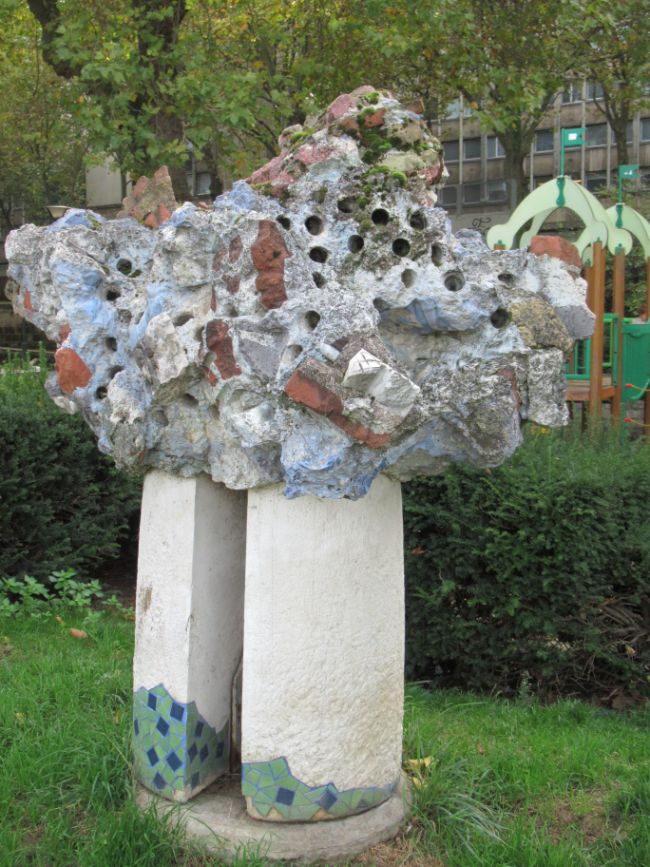
Sculpture in the Jardin Tino Rossi. Photo credit: Marian Jones
But, gradually, I got into it. I wandered the paths, which basically led along the riverbank, deviating here and there up to a concrete esplanade or a little clearing. Every sculpture was a new surprise. Often I thought they resembled something, but I couldn’t be sure. Was that a misshapen tank parked in the middle of a flower bed? With soldiers firing? Or maybe a dalek, perhaps one which had been melted down and not quite fully remolded? Would it be okay to sit on one of those marble blocks, handily placed to face the river? Or would that be disrespectful?
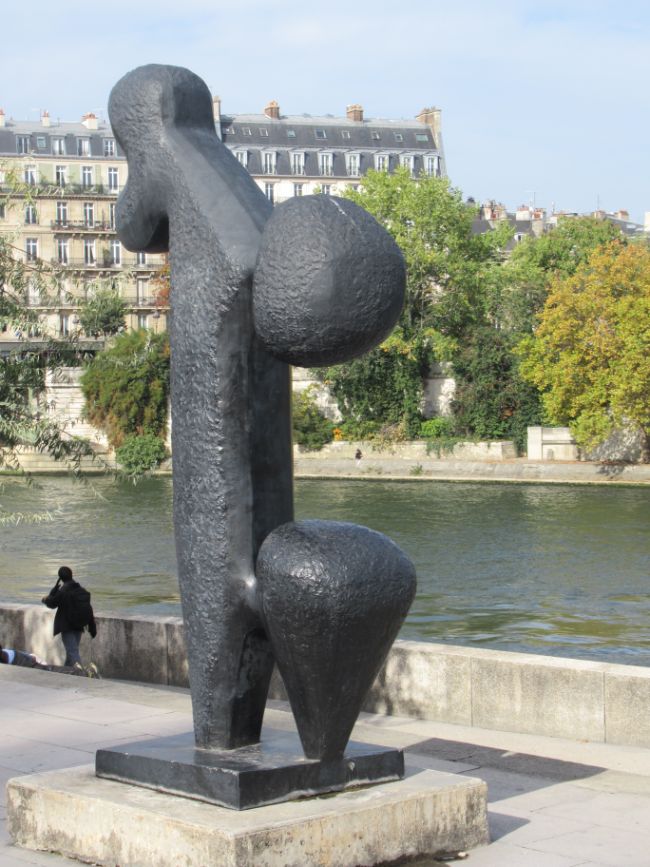
Sculpture in the Jardin Tino Rossi. Photo credit: Marian Jones
Most sculptures were labeled, but that didn’t always demystify. Marta Colvin’s “Le Grand Signe” looked like a road sign with pointers in all directions. A city center junction? Or a metaphor for modern life? I could not see that “La Grande Fenêtre” looked like a window, discerning rather an elephant minus its head and trunk. I think I preferred the ones labeled simply “Sculpture,” leaving me to make of it whatever I wished. If I’d had a companion, we would certainly have discussed all this further and I guess that’s the point: wander, reflect, muse…
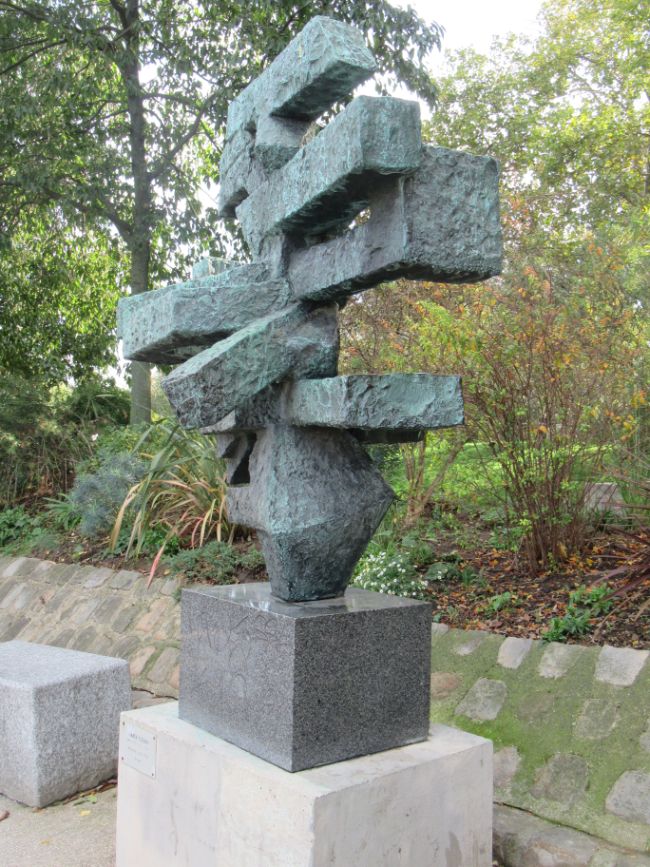
“Le Grand Signe” in the Jardin Tino Rossi. Photo credit: Marian Jones
It wasn’t just the sculptures which took me by surprise. In one little clearing, fitness equipment had been installed on a red clay surface, fenced off like a tennis court. The sun dappled through the surrounding trees, revealing one solitary user, a kimono-clad lady walking up and down, clapping rhythmically, her eyes shut in contemplation. At another spot, the trees parted to reveal a mini amphitheater right at the water’s edge. The sounds of Latin America drifted out from a portable player and a solitary couple were dancing a salsa, quite oblivious to the little group of spectators who had gathered to watch. I knew there’s dancing here most evenings, and indeed an annual dance festival, but I liked that this couple had chosen their own moment.
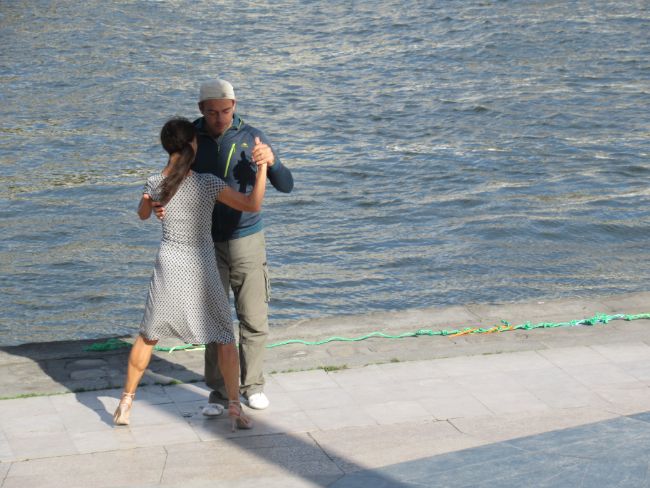
A couple dancing the salsa on the quay. Photo credit: Marian Jones
I followed the walk to the far end, perhaps a kilometer in total. The tree-lined pathways were inviting – plane trees, willows, pines, poplars – as was the ever-changing array of little flower beds, lawns and benches. And there were more sculptures of course. One enormous cylinder was criss-crossed with metal frames and discs blowing in the breeze, vaguely nautical in theme, perhaps? A selection of giant steel rings was labeled “Mind Accumulation,” which helped my understanding not at all. A huge brick-red shape (a flowerpot on its side?), fashioned, said the nearby plaque, from polyester, was simply called “Sculpture.”
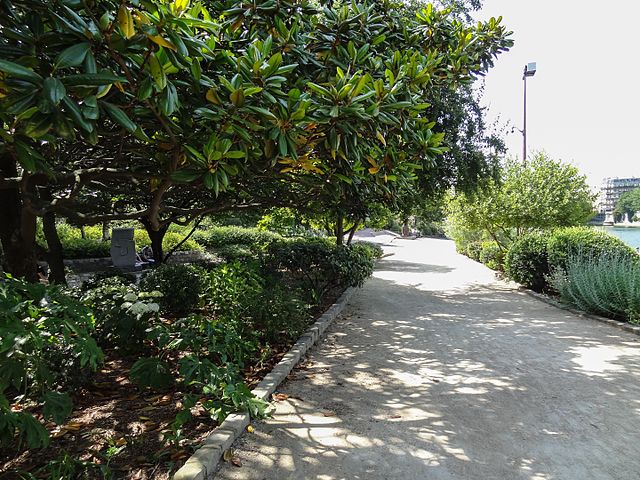
One of the many paths through Jardin Tino Rossi, shadowed by trees and numerous plants to enjoy beside the River Seine. Photo credit: Eutouring/ Wikimedia Commons
The 30 or so pieces dotted through the park were made by artists of various nationalities, many born in the 1920s and 30s. Could their strange takes on reality be responses to the devastation they experienced as young adults in World War II? It would be too neat to try and fit one theory to so many very different pieces, but maybe there was something in that. Certain works, however, seemed designed simply to delight. I was charmed to find that the piece which resembled a huge bird bath was indeed labeled “Bird Bath.” And, set into a little hillock were tiny doors, windows and a sort of chimney, all in bright colors, which left me wondering whether gnomes lived here.
Along the riverside, just before the bridge, was a line of enormous shrub-filled plant pots. The pathway at this point was concreted over, the noise from workmen drilling on the Pont d’Austerlitz just above me was intrusive, yet these decorations stood in proud defiance, a last remnant of the haven I was leaving. It took a few minutes to cross the bridge and find the riverside path on the other side which would lead back to my starting point, but that too offered an escape from the traffic and the clamor. I passed clusters of people out relaxing: the black-clad teens who had brought their own noisy beatbox, an elderly man who called his inquisitive bulldog away with the memorable phrase, “Allez, viens Bonaparte.“

Flowers in the Musée de la sculpture en plein air, a collection of outdoor sculpture located on the banks of the Seine in the 5th arrondissement. Photo credit: Guilhem Vellut / Wikimedia Commons
On the river itself, a noisy party – a works outing? – was happening on one passing riverboat. One person was trying to assemble a group photo, about 40 others were screeching advice. Lunch had possibly been fairly liquid. A group of river police arrived, their official status affirmed by uniformed lifejackets and a tricolore fluttering at the back of their boat. They pulled up to the bank to check what was going on. Nothing much, just people enjoying the sunshine. So they set off again, the blue light fixed to the back of the boat, blinking on and off as it disappeared up the river.
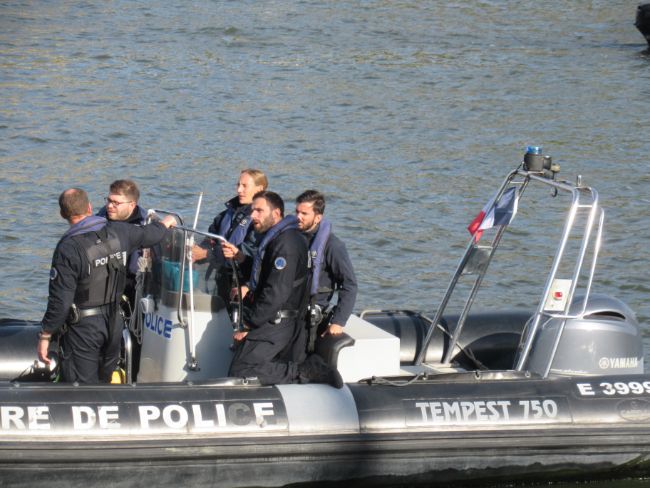
River police patrolling the Seine. Photo credit: Marian Jones
Lead photo credit : Dancing by the Seine on a summer's evening
More in Flâneries in Paris
